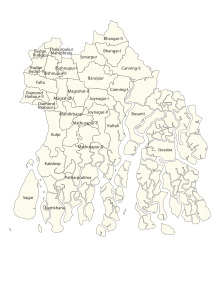Population
According to the 2011 Census of India, Sonarpur CD block had a total population of 219,863, of which 175,713 were rural and 44,150 were urban. There were 112,238 (51%) males and 107,625 (49%) females. There were 22,880 persons in the age range of 0 to 6 years. The Scheduled Castes numbered 116,950 (53.19%) and the Scheduled Tribes numbered 3,069 (1.40%). [9]
According to the 2001 Census of India, the Sonarpur CD block had a total population of 167,348, out of which 86,012 were males and 81,336 were females. The Sonarpur CD block registered a population growth of -41.56% during the 1991-2001 decade. Decadal growth for the South 24 Parganas district was 20.89%. Decadal growth in West Bengal was 17.84%. The Scheduled Castes at 99,567 formed more than one-half the population. The Scheduled Tribes numbered 4,348. [10] [11] [12]
Census Towns in the Sonarpur CD block (2011 census figures in brackets): Radhanagar (6,675), Danga (6,766), Ramchandrapur (8,196), Bidyadharpur (4,630), Kalikapur (5,860), Chak Baria (4,914) and Sahebpur (7,109). [9]
Large villages (with 4,000+ population) in the Sonarpur CD block (2011 census figures in brackets): Atghara (4,284), Ranabhutia (4,196), Bhagabanpur (11,177), Tardaha (4,706), Khurigochhi (6,023), Mali Puuria (5,858), Bhabanipur (4,007), Mathurapur (4,460), Joykrishnapur Chairi (6,436), Banhugli (11,103), Baruli (4,152) and Raypur (4,098). [9]
Other villages in the Sonarpur CD block include (2011 census figures in brackets): Paighat (2,360), Pratapnagar (2,785) and Langalber (2,058). [9]
Literacy
As per the 2011 census, the total number of literates in the Sonarpur CD block was 156,911 (79.66% of the population over 6 years) out of which males numbered 86,132 (85.62% of the male population over 6 years) and females numbered 70,779 (73.43% of the female population over 6 years). The gender disparity (the difference between female and male literacy rates) was 12.19%. [9]
In the South 24 Parganas district, literacy was 77.51%. [13] Literacy in West Bengal was 77.08% in 2011. [14] Overall literacy in India in 2011 was 74.04%. [14]
In the 2001 Census of India, the Sonarpur CD block had a total literacy of 70.74% for the 6+ age group. While male literacy was 79.87%, female literacy was only 61.07%. The South 24 Parganas district had a total literacy rate of 69.45%, male literacy being 79.19% and female literacy being 59.01%. [10]
See also – List of West Bengal districts ranked by literacy rate
Religion
In the 2011 Census of India, Hindus numbered 179,174 and formed 81.49% of the population in the Sonarpur CD block. Muslims numbered 34,989 and formed 15.92% of the population. Others numbered 5,700 and formed 2.59% of the population. Amongst the others, Christians numbered 3,562. [16] In 2001, Hindus were 80.26% of the population, while Muslims and Christians were 17.69% and 1.81% of the population respectively.
The proportion of Hindus in the South Twenty-four Parganas district has declined from 76.0% in 1961 to 63.2% in 2011. The proportion of Muslims in the South Twenty-four Parganas district has increased from 23.4% to 35.6% during the same period. Christians formed 0.8% in 2011. [17]


















